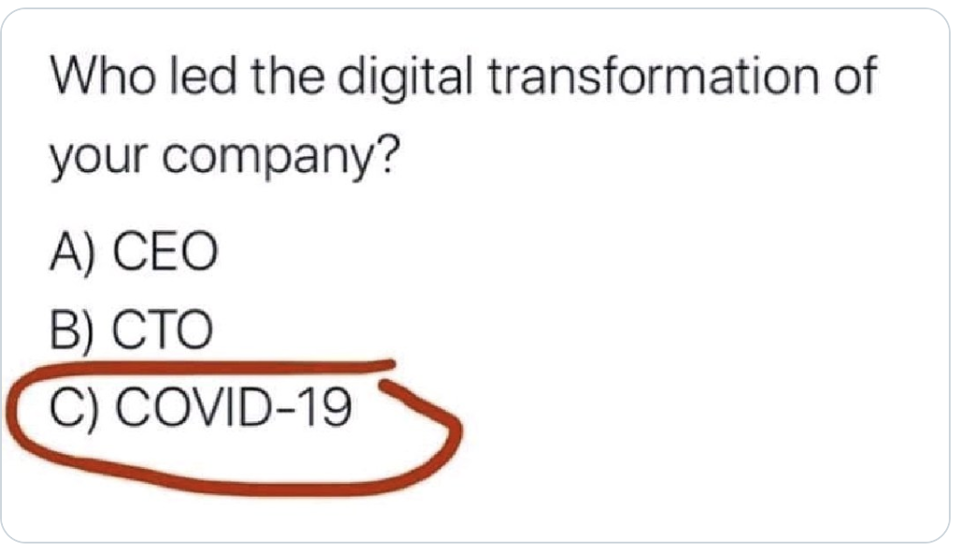I always thought “digital transformation” was just another buzzword like “big data” or “industry 4.0”. As part of my consulting work I however meet successful companies, usually profitable ones, which perform their business same as they used to for the past years, using only minimum digital tools. And suddenly, that just is not enough. Sometimes they are production companies, but more often they are wholesale or retail. They need to digitally transform. So it looks it’s not a buzzword after all.
I am publishing this article in the age of coronavirus, but don’t get me wrong. I wanted to write about this some time ago. Now it’s just that much more relevant.

Brick’n’mortar company - endangered species
So what do the companies I mentioned earlier in common? A typical sign is IT is considered to be a cost center with the inevitable KPI - cost. IT is often limited to running the company laptops, printers and network. The IT support team also usually performs analyst and project management roles of outsourcing partners. There is a big push to use standardized solutions such as ERP systems and ready-made e-commerce suites. Even when there is some custom development, it’s always outsourced. Sometimes that’s what the IT managers prefer, since they are often more from the operations side of things. More often it’s mandated from above, because “outsourcing is more cost effective”.
This maybe worked ten years ago, even five if your industry is more traditional. As I wrote earlier, these companies are successful and profitable, so they had to do something right in the past. They don’t know that they need to undergo a digital transformation. It’s only logical. Nobody wakes up in the morning thinking “Hey, let’s digitally transform ourselves today”, same as revolutions aren’t usually pre-planned.
The Project
Usually it begins as The Project. Implementing new e-commerce website, ERP system upgrade, new app for the sales floor staff. First instinct is to ask current suppliers. On the face of it, it’s logical and, let’s be honest, easiest and safest. Unfortunately one of the downsides of outsourcing manifests here - misaligned interests of the parties. And so it happens, that your current outsourcing partner promises to deliver what you asked for. Let’s put aside the fact that more often than not the company does not even know what to ask for. The problem is that in these cases ERP vendors deliver e-commerce sites or vice versa, the ERP system is bolted on top an e-commerce platform. Only in the rarest of cases will the vendor tell you “You know what? We could deliver what you ask, but you’ll probably be better off implementing XY with someone else”.
<shameless-plug>
Here is where external consultant really pays off.
</shameless-plug>
Second major problem of outsourcing, at least the old-skool one, is it’s primarily focused on project delivery. With analysis phase, two-hundred-page requirements document, budgeting, negotiations, implementation phase, testing, go-live and disaster. It has two advantages:
- It’s fairly predictable - mainly the disaster at the end is pretty much guaranteed
- You can blame the inevitable disaster on the vendor
There are other ways
Since I wrote how not to do it, it’s only fair to tell you how to do it better. I have bad news though: It’s not easy and involves more work. You will have to take much more responsibility.
I don’t mean you should hire developers right away and start developing everything in-house. Not only would you most probably fail, if you have no experience with development, but it makes no sense in most cases. There are many excellent products in any area, open-source or commercial, that solve 90% of what you might need.
On the other hand, it would be naive to think you can buy a ready-made solution, someone installs and launches it for you and you are done. If someone is promising you this, they want to sell it to you.
The important part is to be able to choose right from existing solutions for those 90% and the remaining 10% custom develop yourself, of have someone to develop it for you. I need to stress, that by the 90/10 ratio–exact numbers are not really important here–I don’t mean the ratio of importance or cost. The custom 10% can easily eat up half of your IT budget and at the same time be the thing, that sets you apart from your competition. This is fine.
In order to be able to choose right, you need internal competence, or at least hire someone, who will get to know your company well and will be vested in your success. It can be your current vendor, but then you need to have an extremely high trust relations with them, which is not very common.

Partnership
As you get to the phase, when you know what you want to custom build, or have built, you need to pick a partner. The term partner is really in place here, because you are looking for someone you will feel great working with and who will complement you. This is much more important, than promises of lower cost or earlier deadlines.
You are looking for someone, who will stand by you as you grow and become independent, if you choose to do so in the future. If a piece of technology is strategically important for your future, sooner or later you will arrive at a point, where you will have to take it under your full control and you will want to maintain and develop it yourself. Only that way you can truly digitally transform.
When choosing your potential partner, ask questions such as:
- Who owns the source code, what is it’s license, is the source code available?
- Can our developers or analysts become part of the implementation team?
- How open and modular is the platform you are building upon?
- Can we gradually shift the development towards our internal team?
First steps
When I succeed in convincing the company to take their fate more firmly into their hands, the immediate questions is: Where do we begin? Which position should we internalize first? The answer, as usual, is “it depends”, but most of the time it’s analytical roles. If you can find someone for the role of system architect, take them right away. But more likely you will be successful with an analyst or product manager. Overall, first you are looking for the people able to interact with your chosen partner on your behalf. They should be able to decide what to buy and what to build, or at least help you find someone who can answer these questions.
Later, you will seek other roles, such as testing, programmers and other development roles, but that’s for a different article.
I wish you good luck and a lot of courage on your journey.
Comments